Bennemann K.H., Ketterson J.B. Superconductivity: Volume 1: Conventional and Unconventional Superconductors; Volume 2: Novel Superconductors
Подождите немного. Документ загружается.

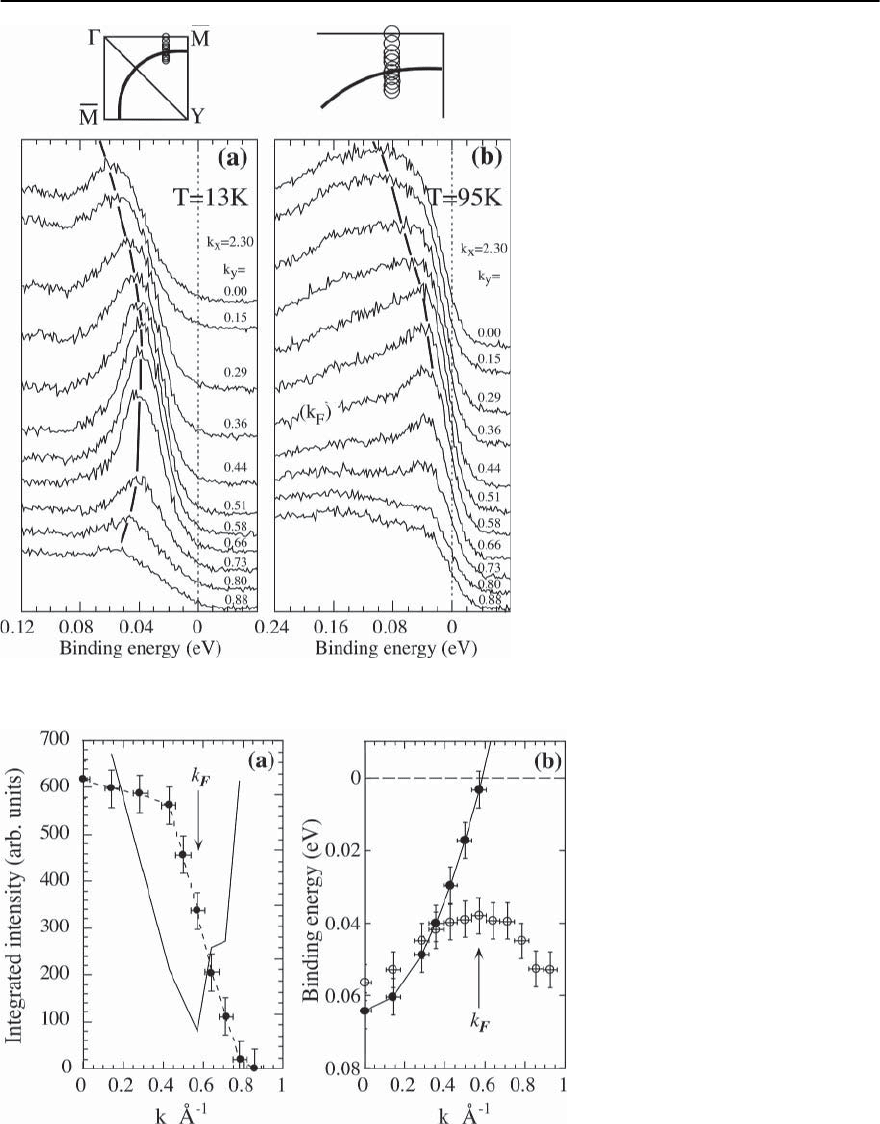
17 Photoemission in the High-T
c
Superconductors 949
Fig. 17.20. (a) Superconducting state and (b)
normal stateEDC’s for a near optimalT
c
=87K
Bi2212 sample for a set of k values (in units
of 1/a) shown in the Brillouin zone at the top.
Note the different binding energy scales in (a)
and (b)
Fig. 17.21. (a) Integrated intensity ver-
sus k from the normal state data of
Fig.17.20 (b)shownbyblack dots gives
information about the momentum dis-
tribution n(k). The derivative of the in-
tegrated intensity is shown by the black
curve (arbitrary scale). The Fermi sur-
face crossing k = k
F
is identified by the
minimum in the derivative. (b)Normal
state dispersion (closed circles)andSC
state dispersion (open circles) obtained
from EDC’s of Fig.17.20.Note the back-
bending of the SC state dispersion for k
beyond k
F
,which is a clear indication of
particle–hole mixing. The SC state EDC
peak position at k
F
is an estimate of the
SC gap at that point on the Fermi sur-
face
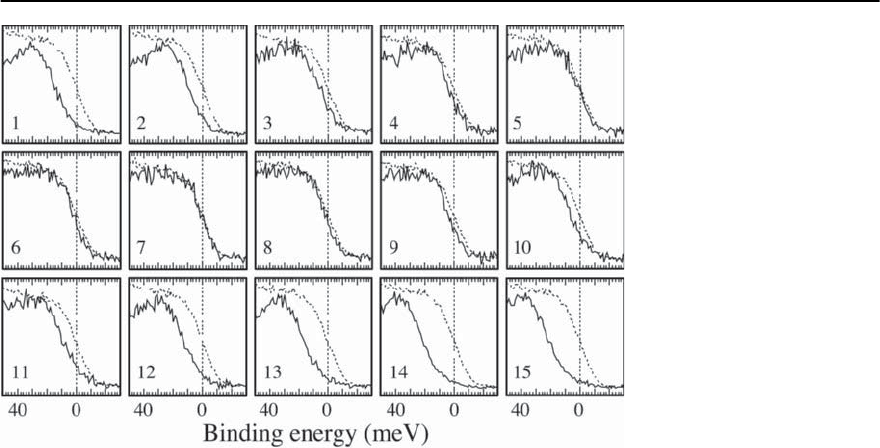
950 J.C. Campuzano, M.R. Norman, and M. Randeria
Fig. 17.22. Bi2212 spectra (solid
lines)foran87KT
c
sample
at 13 K and Pt spectra (dashed
lines) versus binding energy
(meV) along the Fermi surface
in the Y quadrant. The photon
polarization and BZ locations
of the data points are shown in
the in set to Fig. 17.23
There are three important conclusions to be
drawn from Fig. 17.21 (b). First, the bending back
of the SC state spectrum for k beyond k
F
is direct ev-
idence for p–h mixing in the SC state.Second, the en-
ergy of closest approach to ! =0isrelatedtotheSC
gap that has opened up at the FS, and a quantitative
estimate of this gap will be described below. Third,
the location of closest approach to ! = 0(“minimum
gap”) coincides, within experimental uncertainties,
with the k
F
obtained from analysis of normal state
data.
In fact by taking cuts in k-space which are per-
pendicular to the normal state Fermi surface one can
map out the “minimum gap locus” in the SC state,
or for that matter in any gapped state (e.g., the pseu-
dogap regime to be discussed in the following Sec-
tion). We emphasize that particle–hole mixing leads
to the appearance of the “minimum gap locus” and
this locusin thegappedstategivesinformationabout
the underlying Fermi surface. (By this we mean the
Fermi surface on which the SC state gap appears be-
low T
c
). In fact, the observation of p–h mixing in
the ARPES spectra is a clear way of asserting that
the gap seen by ARPES is due to superconductivity
rather than of some other origin,e.g., charge or spin-
density wave formation.
17.5.2 Quantitative Gap Estimates
The first photoemission measurements of the SC
gap in the cuprates was by Imer et al. [69] using
angle-integrated photoemission, and by Olson and
coworkers [70] using angle-resolved photoemission.
The first identification of a large gap anisotropy con-
sistent with d-wave pairing was made by Shen and
coworkers [67].Ding et al.[21,68]subsequently made
quantitative fits to the SC state spectral function to
study the gap anisotropy in detail.
We now discuss the quantitative extraction of the
gap at low temperatures (T T
c
) following Ding
et al. [68]. In Fig. 17.23, we show the T = 13K EDCs
for an 87 K T
c
sample for various points on the main
band FS in the Y -quadrant. Each spectrum shown
corresponds to the minimum observable gap along
asetofk points normal to the FS, obtained from
a dense sampling of k-space. (The large dispersion
along Y, of about 60 meV within our momentum
window ık =0.045/a
∗
, makes it hard to locate k
F
accurately and to map out the nodal region. To this
end the we use a step size of ık/2normaltotheFermi
surface and ık along it.) We used 22 eV photons in a
Y ⊥ polarization, with a 17 meV (FWHM) energy
resolution, and a k-window of radius 0.045/a
∗
.
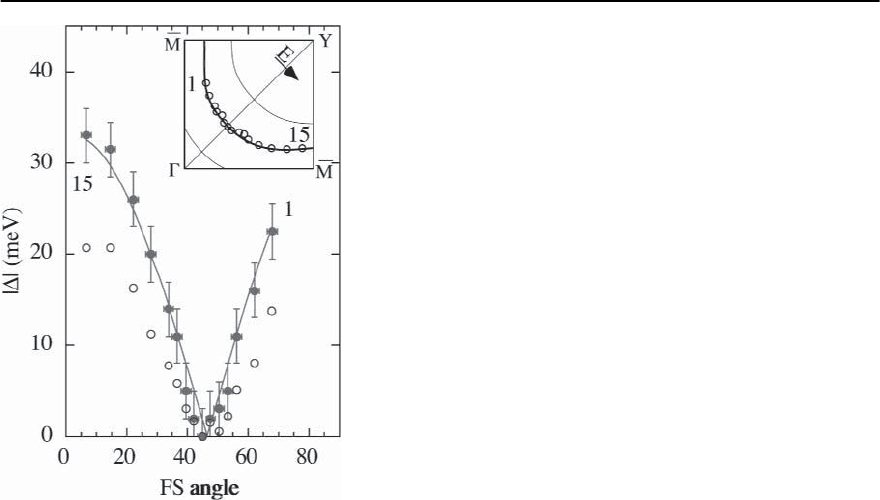
17 Photoemission in the High-T
c
Superconductors 951
Fig. 17.23.Y quadrant gap in meV versus angleon the Fermi
surface (filled circles) from fits to the data of Fig. 17.22.
Open symbols show leading edge shift with respect to Pt
reference. The solid curve is a d-wave fit to the filled sym-
bols
The simplest gap estimate is obtained from the
mid-point shift of the leading edge of Bi2212 rela-
tive to a good metal (here Pt) in electrical contact
with the sample. This has no obvious quantitative
validity, since the Bi2212 EDC is a spectral func-
tion while the polycrystalline Pt spectrum (dashed
curve in Fig. 17.22) is a weighted density of states
whose leading edge is an energy-resolution limited
Fermi function. We see that the shifts (open circles
in Fig.17.23) indicate a highly anisotropic gap which
vanishes in the nodal directions, confirming earlier
results by Shen et al. [67]. These results are qualita-
tively similar to one obtained from the fits described
below.
Next we turn to modeling [21,68] the SC state data
in terms of spectral functions. It is important to ask
how can we model the non-trivial line shape (with
the dip-hump structure at high !) in the absence of
a detailed theory, and, second, how do we deal with
the extrinsic background?We argue as follows:in the
large gap region near (, 0), we see a linewidth col-
lapse for frequencies smaller than ∼ 3 upon cool-
ing well below T
c
. Thus for estimating the SC gap at
the low temperature, it is sufficient to look at small
frequencies, and to focus on the coherent piece of
the spectral function with a resolution-limited lead-
ing edge. (Note this argument fails at higher tem-
peratures, e.g., just below T
c
). This coherent piece is
modeled by the BCS spectral function, Eq. (17.11).
The effects of experimental resolution are taken
into account via
˜
I(k, !)=I
0
ık
dk
+∞
−∞
d!
R(! − !
)f (!
)A(k
, !
) ,
(17.12)
where R(!), the energy resolution, is a normalized
Gaussian and ık is the k-window of the analyzer. In
so far as the fitting procedure is concerned, all of the
incoherent part of the spectral function is lumped
together with the experimental background into one
function which is added to the
˜
I above. Since the gap
is determined by fitting the resolution-limited lead-
ing edge of the EDC, its value is insensitive to this
drastic simplification. To check this, we have made
an independent set of fits to the small gap data where
we do not use any background fitting function, and
only try to match the leading edges, not the full spec-
trum. The two gap estimates are consistent within
a meV. Once the insensitivity of the gap to the as-
sumed background is established, there are only two
free parameters in the fit at each k:theoverallin-
tensity I
0
and the gap ||; the dispersion
k
is known
from the normal state study, the small linewidth is
dominated by the resolution.
The other important question is the justification
for using a coherent spectral function to model the
rather broad EDC along and near the zone diago-
nal. As far as the early data being discussed here
is concerned, such a description is self-consistent
[21, 68], though perhaps not unique, with the en-
tire width of the EDC accounted for by the large
dispersion (of about 60 meV within our k-window)
along the zone diagonal. More recent data taken
along (0, 0) to (, ) with a momentum resolution of
ık 0.01/a
∗
fully justifies this assumption by re-
solving coherent nodal quasiparticles in the SC state;
see Sect. 17.7.7.

952 J.C. Campuzano, M.R. Norman, and M. Randeria
The gaps extracted from fits to the spectra of
Fig. 17.22 are shown as filled symbols in Fig. 17.23.
For a detailed discussion of the error bars (both on
the gap value and on the Fermi surface angle), and
also of sample-to-sample variations in the gap esti-
mates, we refer the reader to [68]. The angular vari-
ation of the gap obtained from the fits is in excel-
lent agreement with |cos(k
x
)−cos(k
y
)| form. The
ARPES experiment cannot of course measure the
phase of the order parameter, but this result is in
strong support of d
x
2
−y
2
pairing [66]. Such an order
parameter arises naturally in theories with strong
correlations and/or antiferromagnetic spin fluctu-
ations [71]. Moreover, the functional form of the
anisotropy we find is consistent with electrons in the
Cooper pair residing on neighboring Cu sites. That
is, ARPES gives information on the spatial range of
the pair interaction which is difficult to obtain from
other techniques.
Finally we comment on the temperature depen-
dence of the gap. Unfortunatelywith increasing tem-
perature the linewidth grows and a simple BCS-type
modeling (valid for T T
c
) of just the coherent
part of the spectral function is not possible. While
T-dependence of the leading edge can certainly be
used as a rough guide, this estimate is affected by
both the gap and the linewidth (the diagonal self-
energy). We will discuss methods for modeling the
SC state data in Sect. 17.7.
For completeness, we add a remark clarifying the
earlier observation of two nodes in the X-quadrant
[21], and the related non-zero gap along X in the
X|| geometry [21, 72]. It was realized soon after-
wards that these observations were related to gaps
on the superlattice bands [44], and not on the main
band. To prove this experimentally, the X-quadrant
gap has been studied in the X ⊥ geometry [68] and
found to be consistent with Y-quadrant d
x
2
−y
2
result
described above.
17.5.3 Doping Dependence of the SC Gap
There are two important issues to be addressed about
the doping dependence: How does the maximum
gapchangewithdoping?andhowdoesthegap
anisotropy evolve with doping?
ARPES results on underdoped samples show that
the maximum gap increases [73,74] with decreasing
hole concentration. For a recent compilation of gap
versus doping results [59] in Bi2212, see Fig. 17.50
of Sect. 17.7.6. Identical results have also been ob-
tained by tunneling spectroscopy [75]. This was at
first quite unexpected since T
c
decreases as one un-
derdopes from optimality. The fact that 2/k
B
T
c
is
not constant with doping and can become an order of
magnitude larger than its BCS weak-coupling value
is very clear evidence that the SC phase transition on
the underdoping side is qualitatively different from
the BCS transition, a point that we will return to in
the next Section on pseudogaps.
We next turn to the question of the SC gap
anisotropy as a function of doping. In this case it
is the behavior of the gap in the vicinity of the
node which is the most important since all low tem-
perature T T
c
thermodynamic and transport
properties are controlled by thermal excitation of
quasiparticles in the vicinity of the nodes (where
the SC gap vanishes on the Fermi surface). These
low energy excitations have a Dirac-like spectrum
E(k)=
v
2
F
k
2
⊥
+ v
2
2
k
2
where k
⊥
(k
)arethecom-
ponents of the k perpendicular (tangential) to the
Fermi surface, and measured from the nodal point.
Here v
F
is the nodal Fermi velocity controlling the
dispersion perpendicular to the Fermi surface, while
v
2
= ∂
k
/∂k
isthegapslopeatthenodalpoint.
The density of states for low energy excitations is
then given by N(!)=2!/(v
F
v
2
)for! (in
units where = 1). This leads to characteristic tem-
perature dependences for various low temperature
properties with coefficients essentially determined
by v
F
and v
2
.Specifically forT T
c
,the specific heat
goes like C(T)=c
1
T/(v
F
v
2
); the thermal conductiv-
ity goes like (T)/T = c
2
(
v
F
/v
2
+ v
2
/v
F
)
and the su-
perfluid density goes like
s
(T)=
s
(0)−c
3
(v
F
/v
2
)T.
Here c
1
and c
2
are known constants while c
3
con-
tains (a prioriunknown) multiplicative Fermi liquid
parameters [76,77].
Clearly ARPES has a unique ability to indepen-
dently measure both v
F
, using the dispersion of the
nodal quasiparticle,and v
2
, using the slope of the SC
gap at the node. One can then make detailed compar-
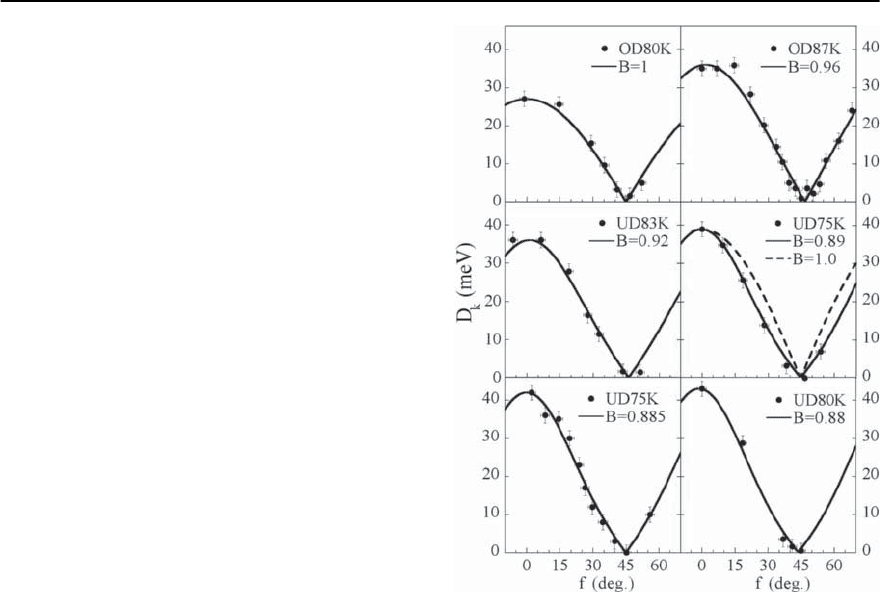
17 Photoemission in the High-T
c
Superconductors 953
ison with various bulk measurements, and thereby
test the validity of the description of the low temper-
ature properties of the SC state in terms of weakly in-
teracting quasiparticles [76–78]. This is particularly
important given the lack of sharply defined quasi-
particles in the normal state of the cuprates.
With these motivations in mind, a detailed mea-
surement of the shape of the superconducting gap
in Bi2212 as a function of doping was carried out
by Mesot et al. [79]. Although these measurements
were carried out at a time when the energy and
momentum resolutions were lower than those cur-
rently available, they still give useful information
because the gap over the full range of angles over
the irreducible zone was measured. Using the sim-
ple BCS spectral function fits (described above) and
taking into account the measured dispersion and the
known energy and momentum resolutions, Mesot et
al.found the results shown in Fig. 17.24. The sim-
ple d-wave gap =
0
cos(2) (Fig. 17.23) is mod-
ified by the addition of the first harmonic
k
=
max
[B cos(2)+(1−B)cos(6)], with 0 ≤ B ≤ 1.
Note that the cos(6) term in the Fermi surface har-
monics can be shown to be closely related to the
tight binding function cos(2k
x
)−cos(2k
y
), which
represents next nearest neighbors interaction, just
as cos(2) is closely related to the near neighbor
pairing function cos(k
x
)−cos(k
y
). From Fig. 17.24
we find that while the overdoped data are consistent
with B 1, the parameter B decreases as a function
of underdoping.
Before discussing the doping dependence of the
results in detail, let us first look at the comparisons
between ARPES and other probes near optimality.
Low temperature specific heat data on Bi2212 is not
available,but thethermal conductivity hasbeen mea-
sured by Taillefer and coworkers [78] on an optimal
T
c
= 89K sample. Now one can use the /T formula
given abovewith the coefficientc
2
= k
2
B
n/3d,where
n/d is the stacking density of CuO
2
planes. It is im-
portant to note that c
2
is not renormalized by either
vertex corrections or Fermi liquid parameters [77].
Thus one infers v
F
/v
2
=19fromthethermaltrans-
port data [78], which is in remarkable agreement
with the ARPES estimate [79] of v
F
/v
2
20 coming
from the measured values of v
F
=2.5×10
7
cm/s and
Fig. 17.24. Values of the superconducting gap as a func-
tion of the Fermi surface angle obtained for a series of
Bi2212 samples with varying doping. Note two different
UD75 K samples were measured, and the UD83 K sam-
ple has a larger doping due to sample aging [41]. The
solid lines represent the best fit using the gap function:
k
=
max
[B cos(2)+(1−B)cos(6)] as explained in the
text. The dashed line in the panel of an UD75 K sample
represents the gap function with B =1
v
2
=1.2 × 10
6
cm/s for the near optimal T
c
=87K
sample of Fig. 17.24. (We note that in [79] we used
the notation v
for one-half the gap slope at the node,
which is relatedto v
2
defined abovebyv
2
=2v
/k
F
.)
The comparison of ARPES results with the slope
of the superfluid density
s
∼ 1/
2
obtained from
penetration depth measurements is more compli-
cated, as discussed in more detail in [79], for two
reasons. Experimentally, there seem to be discrepan-
cies between the d
−2
/dT results of various groups,
and theoretically the slope of
s
is renormalized by
doping-dependent Fermi liquid parameters [76, 77]
which are not known a priori. These parameters

954 J.C. Campuzano, M.R. Norman, and M. Randeria
characterize the residual interactions between the
nodal quasiparticles in the superconducting state.
Thus, e.g., even at optimality the slope d
−2
/dT ob-
tained using the ARPES estimate of v
F
/v
2
and ig-
noring Fermi liquid renormalization is almost three
times as large as the experimentally measured value
of d
−2
/dT in near optimal Bi2212. This indicates
the importance of Fermi liquid renormalizations in
order to make a quantitative comparison. For more
details on the doping dependence of these renormal-
izations, see [76,79,81].For penetration depth mea-
surements on Bi2212, see [80].
Finally, let us return to the doping dependence of
the results of Fig. 17.24. In contrast to the maximum
gap (at the (, 0)−(, ) Fermi surfacecrossing) in-
creasing as a function of underdoping, noted earlier,
we see the gap slope at the node,which determines v
2
,
decreasing with underdoping. This is a result of the
doping dependence of the B parameter introduced
above.
This surprising observation raises several ques-
tions. First, could the flattening at the node be, in
fact, evidence for a “Fermi arc”, a line of gapless
excitations, in the underdoped materials, especially
since such arcs are seen above T
c
(see Sect. 17.6.3
for further discussion of Fermi arcs in underdoped
materials). Given the error bars on gap estimates in
Fig. 17.24, it is impossible to rule out arcs in all the
samples. Nevertheless, it is clear that there are sam-
ples (especially OD87K, UD80K and UD75K) where
there is clear evidence in favor of a point node rather
than an arc at low temperatures. Furthermore, it is
very important to note that a linear T dependence
of
s
(T) at low temperature, for all doping levels, in
clean samples gives independent evidence for point
nodes, at least in YBCO [82].
Second, is the change in gap anisotropy intrin-
sic, or related to impurity scattering [83]? We can
eliminate the latter explanation on two grounds.The
maximum gap increases as the doping is reduced,
opposite to what would be expected from pair break-
ing due to impurities. Also, impurity scattering is
expected to lead to a characteristic “tail” to the lead-
ing edge [84], for which there is no evidence in the
observed spectra.
Thus the flattening near the nodes with under-
doping does appear to be an intrinsic feature which
may be related to the increased importance of longer
range pairing interactions as one approaches the in-
sulator. It would be of great interest to study the de-
tails of the doping dependence of the gap anisotropy
with the new Scienta detectors which have greatly
improved energy and momentum resolution.
17.6 Pseudogap
In this section we describe one of the most fasci-
nating developments in the study of high T
c
super-
conductors: the appearance of a pseudogap above
T
c
which is seen most prominently on the under-
doped side of the cuprate phase diagram. Briefly
the “pseudogap” phenomenon is the loss of low en-
ergy spectral weight in a window of temperatures
T
c
< T < T
∗
; see Fig. 17.25. The pseudogap regime
has been probed by many techniques like NMR, op-
tics, transport, tunneling, SR and specific heat; for
reviews and references, see [85,86]. ARPES, with its
unique momentum-resolved capabilities, has played
a central role in elucidating the pseudogap phe-
nomenon [41,87–90].
WewilldiscussinthissectionARPESresultson
the anisotropy of the pseudogap, its T-dependence,
its doping dependence, and its effect on the normal
state Fermi surface. We emphasize that for the most
part we will focus on the “low energy” or leading
edge pseudogap, and only mention ARPES evidence
for the “high energy pseudogap” toward the end. We
will conclude the Section with a summary of the con-
straints put by the ARPES data on various theoretical
descriptions of the pseudogap.
17.6.1 Pseudogap near (; 0)
In the underdoped materials,T
c
is suppressedby low-
ering the carrier (hole) concentration as shown in
Fig.17.25.Inthesamplesusedbyourgroup[41,89,90]
underdoping was achieved by adjusting the oxy-
gen partial pressure during annealing the float-zone
grown crystals. These crystals also have structural
coherence lengths of at least 1,250 Å as seen from x-
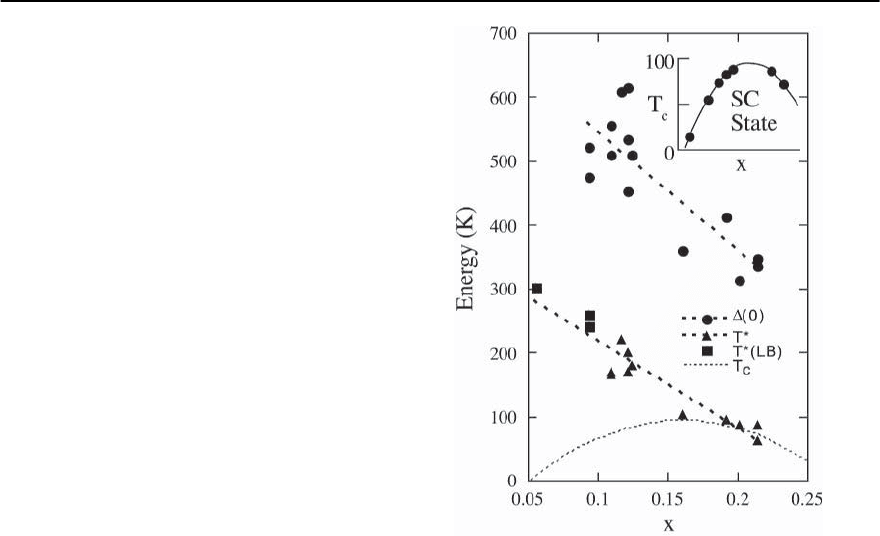
17 Photoemission in the High-T
c
Superconductors 955
ray diffraction,andopticallyflatsurfaces upon cleav-
ing, similar to the slightly overdoped T
c
samples dis-
cussed above.We denote the underdoped (UD) sam-
ples by their onset T
c
: the83 K sample has a transition
widthof2Kandthehighlyunderdoped15Kand10K
have transition widths > 5 K.Other groups have also
studied samples where underdoping was achieved by
cation substitution [87,88].
We now contrast the remarkable properties of the
underdoped samples with the near-optimal Bi2212
samples which we have been mainly focusing on
thus far. We will first focus on the behavior near the
(, 0) point where the most dramatic effects occur,
and come back to the very interesting k-dependence
later. In Fig. 17.26 [74] we show the T-evolution of
the ARPES spectrum at the (, 0) → (, )Fermi
crossing for an UD 83K sample. At sufficiently high
temperature, the leading edge of the UD spectrum
at k
F
and the reference Pt spectrum coincide, but
below a crossover temperature T
∗
180K the lead-
ing edge midpoint of the spectrum shifts below the
chemical potential. In Fig. 17.26 one can clearly see a
loss of low energy spectral weight at 120K and 90K.
It must be emphasized that this gap-like feature is
seen in the normal (i.e., non-superconducting) state
for T
c
=83K< T < T
∗
= 180 K.
The doping dependence of the temperature T
∗
,
below which a leading-edge pseudogap appears near
(, 0), is shown in Fig. 17.25. Remarkably T
∗
in-
creases with underdoping, in sharp contrast with T
c
,
but very similar to the low temperature SC gap, a
point we will return to at the end of the Section. The
region of the phase diagram between T
c
and T
∗
is
called the pseudogap region.
It is important to emphasize that our understand-
ing of the lightly UD samples (e.g., the UD 83 K sam-
ple) is the best among the UD materials. In such sam-
ples all three regimes — the SC state below T
c
,the
pseudogap regime between T
c
and T
∗
and the gap-
less “normal” regime above T
∗
—canbestudiedin
detail. In contrast, in the heavily UD samples (e.g.,
theUD10KandUD15Ksamples),notonlyisthe
SC transition broad, one also has such low T
c
’s and
such high T
∗
’s that only the pseudogap regime is ex-
perimentally accessible. Nevertheless, the results on
the heavily underdoped samples appear to be a natu-
Fig. 17.25. T
∗
(triangles for determined values and squares
for lower bounds) and T
c
(dashed line)asafunctionofhole
doping x.Thex values for a measured T
c
were obtained by
using the empirical relation T
c
/T
max
c
=1−82.6(x −0.16)
2
[91] with T
max
c
= 95 K. Also shown is the low temperature
(maximum) superconducting gap (0) (circles). Note the
similar doping trends of (0) and T
∗
ral continuation of the weakly underdoped materials
and the results (the trends of gap and T
∗
)onthelow
T
c
samples are in qualitative agreement with those
obtained from other probes (see [85,86]).
The T-dependence of the leading-edge midpoint
shift appears to be completely smooth throughthe SC
transition T
c
. In other words, the normal state pseu-
dogap evolves smoothly into the SC gap below T
c
.
Nevertheless, there is a characteristic change in the
lineshape in passing through T
c
associated with the
appearance of a sharp feature below T
c
in Fig. 17.26.
This can be identified as the coherent quasiparticle
peak for T T
c
. The existence of a SC state quasi-
particle peak is quite remarkable given that the nor-
mal state spectra of UD materials are even broader
than at optimality, and in fact become progressively
broader with underdoping. In fact, the low tempera-
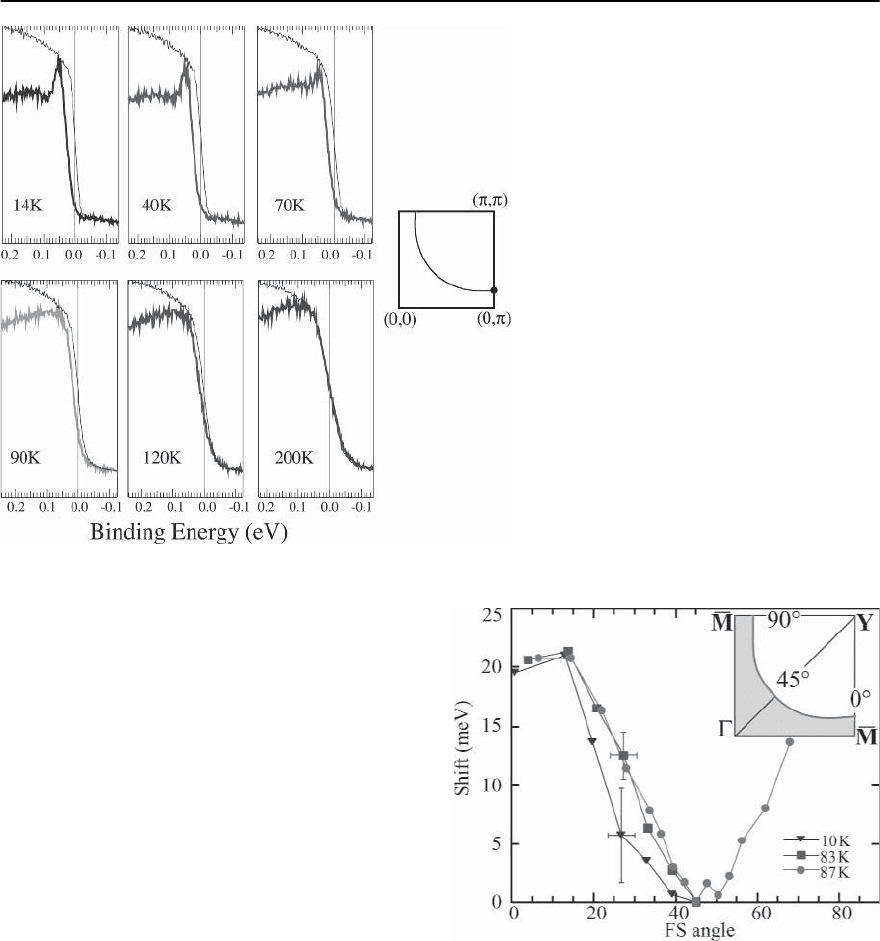
956 J.C. Campuzano, M.R. Norman, and M. Randeria
Fig. 17.26. ARPES spectra along the (, 0) →
(, ) direction for an 83 K underdoped sam-
ple at various temperatures (solid curves). The
thin curves in each panel are reference spec-
tra from polycrystalline Pt used to accurately
determine the zero of binding energy at each
temperature
ture SC state spectra near (, 0) in the UD systems
(see Fig. 17.50 of Sect. 17.7.6) are in many ways quite
similar to those at optimal doping, with the one cru-
cial difference that the spectral weight in the coher-
ent quasiparticle peak diminishes rapidly with un-
derdoping [92,93].
17.6.2 Anisotropy of the Pseudogap
We have already indicated that the pseudogap above
T
c
near the (, 0) point of the zone evolves smoothly
through T
c
into the large SC gap below T
c
,andthus
the two also have the same magnitude. Since the SC
gap has the d-wave anisotropy (discussed in detail in
the preceding section),it is natural to ask: what is the
k-dependence of the pseudogap above T
c
?
The first ARPES studies [87–89] showed that the
pseudogap is also highly anisotropic and has a k-
dependence which is very similar to that of the SC
gapbelowT
c
.Laterwork[90]furtherclarifiedthesit-
uation by showing that the anisotropy has a very in-
teresting temperature dependence.We now describe
these developments in turn.
Fig. 17.27. Momentum dependence of the gap estimated
from the leading-edge shift in samples with T
c
’s of 87 K
(slightly overdoped), 83 K (UD) and 10 K (UD), measured
at 14 K. For the sake of comparison between samples we
made vertical offsets so that the shift at 45
◦
is zero; the
offsets are −3 meV for the 83 K and +2 meV for the 10 K
sample. The inset shows the Brillouin zone with the large
Fermi surface
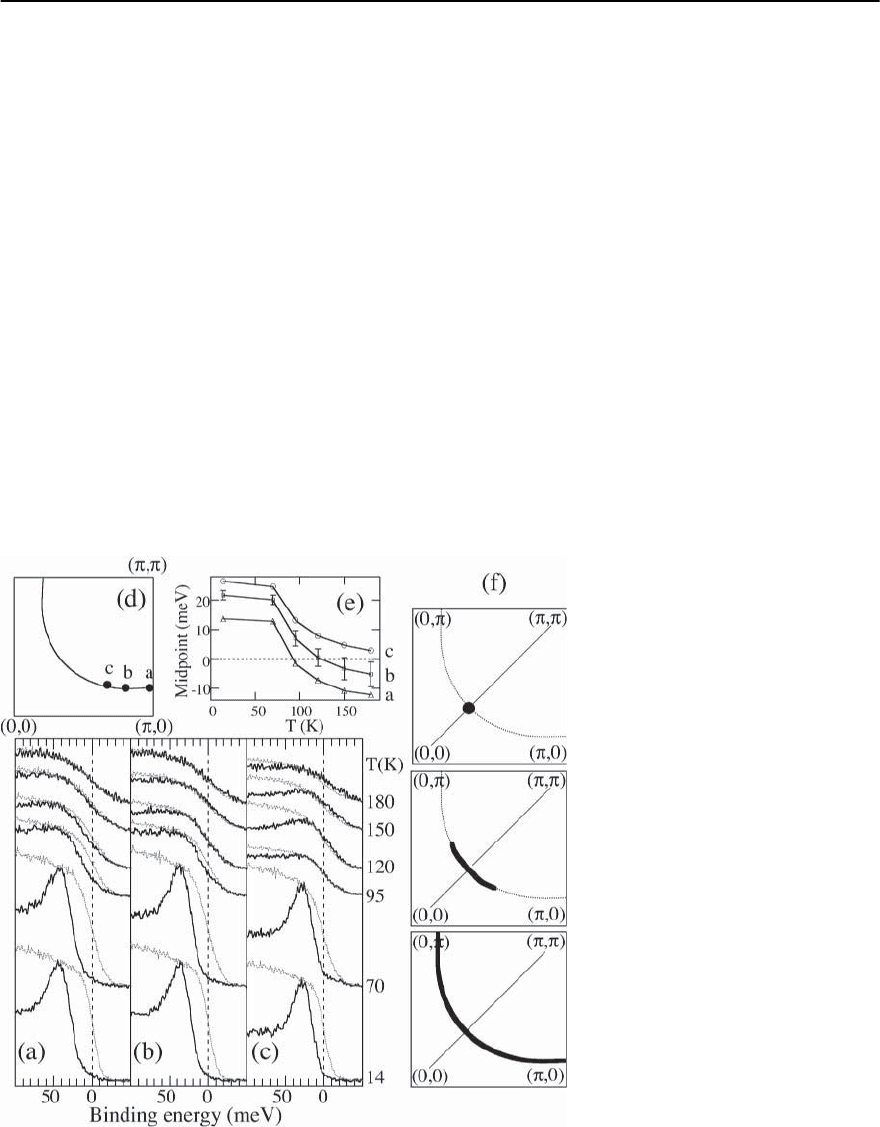
17 Photoemission in the High-T
c
Superconductors 957
In Fig. 17.27 [89] we plot the leading edge shifts
for three samples at 14 K: the slightly overdoped 87 K
and UD 83 K samples are in their SC states while
the UD 10 K sample is in the pseudogap regime. The
gap estimate for each sample was made on the“min-
imum gap locus” (explained earlier in the context of
the SC gap; see further below). The large error bars
on the UD 10K sample come from the difficulty of ac-
curately locating the midpoint of a broad spectrum.
Also there is a flattening of the gap near the node, a
feature that we discussed earlier forthe SC gap in UD
samples.
The remarkable conclusion is that the normal
statepseudogap has a very similar k-dependence and
magnitude as the SC gap below T
c
.
17.6.3 Fermi Arcs
The T-dependence and anisotropy of the pseudo-
gap was investigated in moredetail in [90] motivated
by the following question. Normal metallic systems
are characterized by a Fermi surface, and optimally
doped cuprates are no different despite the absence
of sharp quasiparticles (see Sect. 17.4). On the un-
derdoped side of the phase diagram, however, how
does the opening of pseudogap affect the locus of
low lying excitations in k-space?
In Fig. 17.28 we show ARPES spectra for an UD
83K sample at three k points on the Fermi surface
for various temperatures. The superconducting gap,
as estimated by the position of the sample leading
edge midpoint at low T, is seen to decrease as one
moves from point a near (, 0) to b to c ,closertothe
diagonal (0, 0) → (, ) direction, consistent with a
d
x
2
−y
2
order parameter.At each k point the quasipar-
ticle peak disappears above T
c
as T increases,with the
pseudogap persisting well above T
c
, as noted earlier.
The striking feature which is apparent from
Fig. 17.28 is that the pseudogap at different k points
closes at different temperatures,with larger gaps per-
Fig. 17.28. (a), (b), (c): Spectra taken at
three k points in the Y quadrant of the
zone (shown in (d)) for an 83 K under-
dopedBi2212 sampleatvarious temper-
atures (solid curves). The dotted curves
are reference spectra from polycrys-
talline Pt (in electrical contact with the
sample)used to determinethechemical
potential (zero binding energy). Note
the closing of the spectral gap at dif-
ferent T for different k’s, which is also
apparent in the plot (e)ofthemidpoint
of the leading edge of the spectra as
afunctionofT.(f) Schematic illustra-
tion of the temperature evolution of the
Fermi surface in underdoped cuprates.
The d-wave node below T
c
(top panel)
becomesagaplessarcaboveT
c
(middle
panel) which expands with increasing
T to form the full Fermi surface at T
∗
(bottom panel)
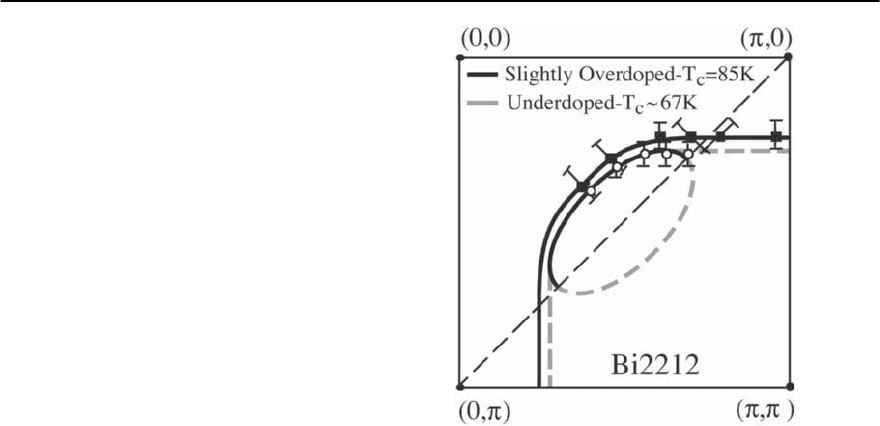
958 J.C. Campuzano, M.R. Norman, and M. Randeria
sisting to higher T’s. At point a,near(, 0), there is a
pseudogap at all T’s below 180 K,at which the Bi2212
leading edge matches that of Pt. As discussed above,
this defines T
∗
above which the largest pseudogap
has vanished within the resolution of our experi-
ment, and a closed contour of gapless excitations —
a Fermi surface — is obtained.The surpriseis that if
we move along this Fermi surface to point b the sam-
ple leading edge matches Pt at 120 K, which is smaller
than T
∗
. Continuing to point c, about halfway to the
diagonal direction, we find that the Bi2212 and Pt
leading edges match at an even lower temperature of
95 K.In addition,spectra measured on the same sam-
ple along the Fermi contour near the (0, 0) → (, )
line shows no gap at any T (even below T
c
) consistent
with d
x
2
−y
2
anisotropy.
One simple way to quantify the behavior of the
gap is to plot the midpoint of the leading edge of the
spectrum; see Fig. 17.28(e). We note that a leading
edge midpoint at a negative binding energy, particu-
larly for k point c, indicates the formation of a peak
in the spectral function at ! =0athighT.Further,
we will say that the pseudogap has closed at a k point
when the midpoint equals zero energy,in accordance
with the discussion above.A clearer way of determin-
ing this will be presented below when we discuss the
symmetrization method, but the results will be the
same. From Fig. 17.28, we find that the pseudogap
closes at point a at a T above 1801K, at point b at
120 K, and at point c just below 95 K. If we now view
these data as a function of decreasing T, the picture
of Fig. 17.28(f) clearly emerges.
With decreasing T, the pseudogap first opens up
near (, 0) and progressively gaps out larger por-
tions of the Fermi contour. Thus one obtains gap-
less arcs which shrink as T is lowered, eventually
leading to the four point nodes of the d-wave SC
gap. The existence of such arcs is apparent from the
first ARPES work on the pseudogap [87], where it
was noted that the Fermi contours in the pseudogap
phase did not extend all the way to the zone boundary
(see Fig. 17.29). Whether the arcs shrink to a point
precisely at T
c
or below T
c
is not clear from the ex-
isting data.As discussed in the preceding section,we
do believe that arcs do not survive deep into the SC
state where there is point node at T T
c
in clean
Fig. 17.29. Fermi level crossings from two Bi2212 samples
of differing oxygen content. The entire zone can be recon-
structed by fourfold rotation about (0,0) (from [87])
samples,as also evidenced by the linear T drop in the
superfluid density at low T.
We next turn to a powerful visualization aid that
makes these results very transparent.This is the sym-
metrization method introduced in [90], which effec-
tively eliminates the Fermi function f from ARPES
data and permits us to focus directly on the spec-
tral function A. Given ARPES data described by
[20] I(!)=
k
I
0
f (!)A(k, !)withthesumover
a small momentum window about the Fermi mo-
mentum k
F
, we can generate the symmetrized spec-
trum I(!)+I(−!). Making the reasonable assump-
tion of particle–hole (p–h) symmetry for a small
range of ! and
k
,wehaveA(
k
, !)=A(−
k
, −!)
for |!|, || less than few tens of meV. It then fol-
lows, using the identity f (−!)=1−f (!), that
I(!)+I(−!)=
k
I
0
A(k, !) which is true even
after convolution with a (symmetric) energy reso-
lution function; for details see the appendix of [8].
The symmetrized spectrum coincides with the raw
data for ! ≤ −2.2T
eff
,where4.4T
eff
is the 10%–90%
width of the Pt leading edge, which includes the ef-
fects of both temperature and resolution.Non-trivial
information is obtained for the range |!|≤2.2T
eff
,
which is then the scale on which p–h symmetry has
